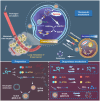Advancements in Cell Membrane-Derived Biomimetic Nanotherapeutics for Breast Cancer
- PMID: 40385497
- PMCID: PMC12083498
- DOI: 10.2147/IJN.S502144
Advancements in Cell Membrane-Derived Biomimetic Nanotherapeutics for Breast Cancer
Abstract
Breast cancer remains the leading cause of female mortality worldwide, necessitating innovative and multifaceted approaches to address its various subtypes. Nanotechnology has attracted considerable attention due to its nanoscale dimensions, diverse carrier types, suitability for hydrophobic drug delivery, and capacity for controlled and targeted administration. Nano-sized particles have become prevalent carriers for therapeutic agents targeting breast cancer, thanks to their reproducible synthesis and adjustable properties, including size, shape, and surface characteristics. In addition, certain nanoparticles can enhance therapeutic effects synergistically. However, the immune system often detects and removes these nanoparticles, limiting their efficacy. As a promising alternative, cell membrane-based delivery systems have gained attention due to their biocompatibility and targeting specificity. These membrane-coated drug delivery systems are derived from various cell sources, including blood cells, cancer cells, and stem cells. Leveraging the unique properties of these cell membranes enables precise targeting of breast cancer tumors and associated biomarkers. Inspired by natural structures, cell membranes disguise nanoparticles in the bloodstream, enhancing their retention time in vivo and improving tumor targeting. Consequently, cell membrane-derived nanoparticles (CMDNPs) have been investigated for their potential applications in breast cancer diagnostics, photothermal therapy (PTT), and vaccine development. This review comprehensively explores the potential and limitations of cell membrane-derived drug delivery systems in clinical applications against breast cancer.
Keywords: active targeting; biomimetic delivery systems; breast cancer; cell membrane-derived nanoparticles; combination therapy.
© 2025 Zeng et al.
Conflict of interest statement
The authors declare that they have no competing interests.
Figures



Similar articles
-
Bone-targeted erythrocyte-cancer hybrid membrane-camouflaged nanoparticles for enhancing photothermal and hypoxia-activated chemotherapy of bone invasion by OSCC.J Nanobiotechnology. 2021 Oct 26;19(1):342. doi: 10.1186/s12951-021-01088-9. J Nanobiotechnology. 2021. PMID: 34702291 Free PMC article.
-
Revolutionizing Neurocare: Biomimetic Nanodelivery Via Cell Membranes.Adv Mater. 2024 Jun;36(26):e2402445. doi: 10.1002/adma.202402445. Epub 2024 Apr 15. Adv Mater. 2024. PMID: 38583077 Review.
-
Cell membrane-coated nanosized active targeted drug delivery systems homing to tumor cells: A review.Mater Sci Eng C Mater Biol Appl. 2020 Jan;106:110298. doi: 10.1016/j.msec.2019.110298. Epub 2019 Oct 13. Mater Sci Eng C Mater Biol Appl. 2020. PMID: 31753336 Review.
-
Advances in Biomimetic Nanoparticles for Targeted Cancer Therapy and Diagnosis.Molecules. 2021 Aug 20;26(16):5052. doi: 10.3390/molecules26165052. Molecules. 2021. PMID: 34443638 Free PMC article. Review.
-
Biomimetic Nanoscale Systems for Targeted Delivery in Cancer: Current Advances and Future Prospects.Curr Drug Metab. 2024;25(6):403-415. doi: 10.2174/0113892002323535240830093452. Curr Drug Metab. 2024. PMID: 39238377 Review.
References
Publication types
MeSH terms
Substances
LinkOut - more resources
Full Text Sources
Medical
Research Materials

